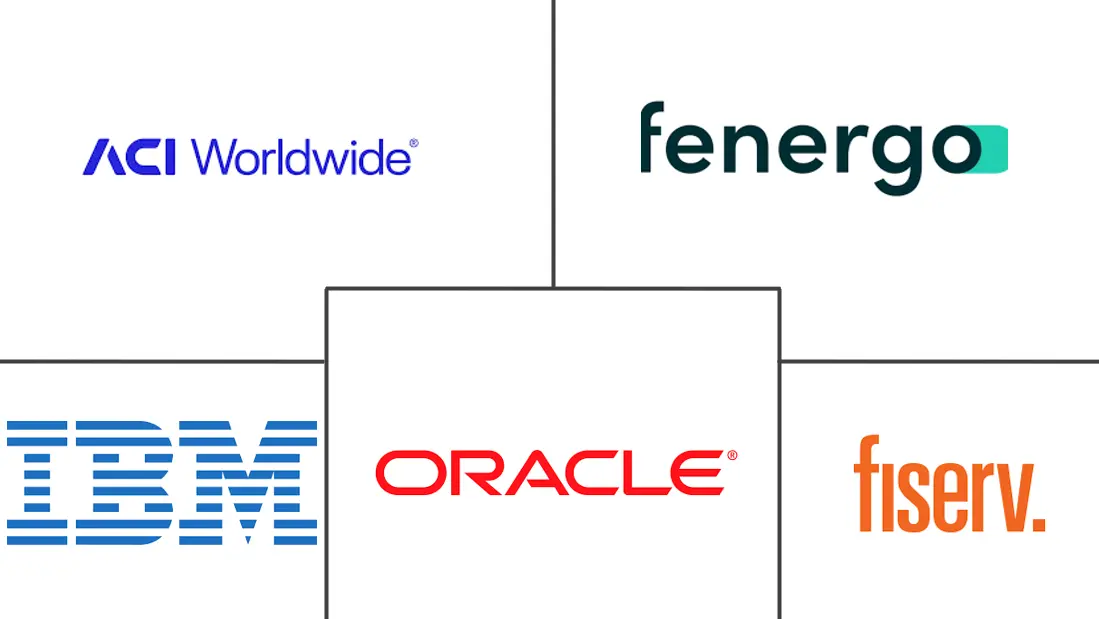Crime Risk Report Market Size and Share
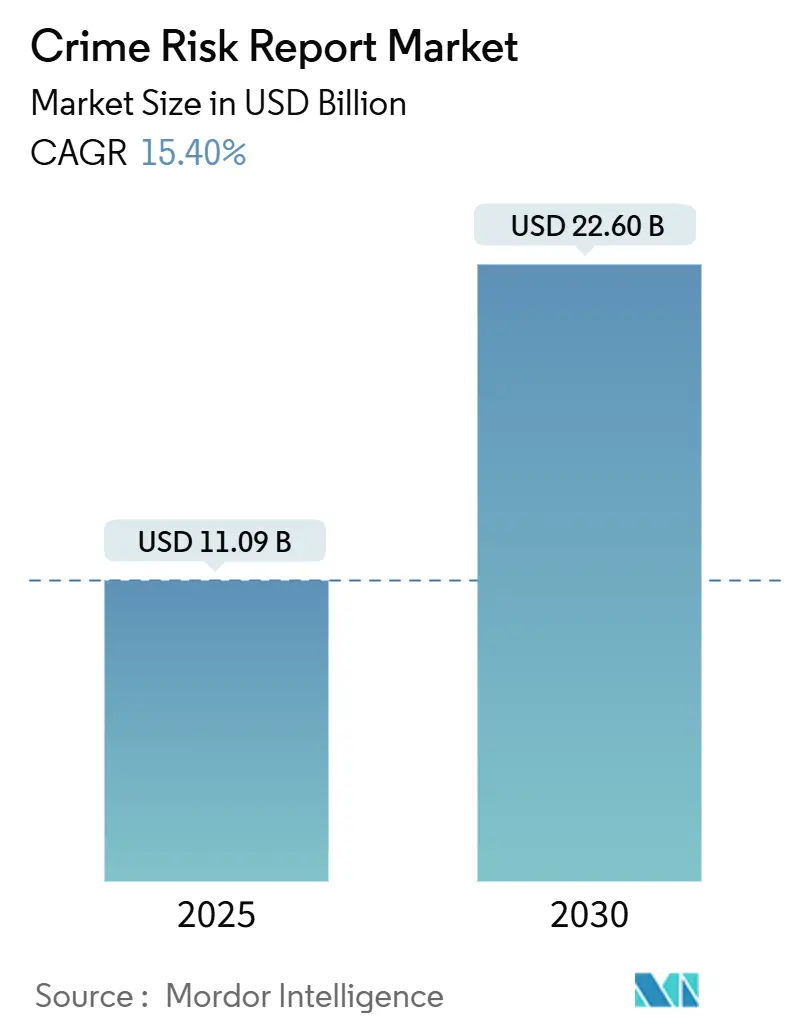
Crime Risk Report Market Analysis by Mordor Intelligence
The Crime Risk Report market size stood at USD 11.5 billion in 2025 and is on course to reach USD 28.9 billion by 2030, advancing at a 20.4% CAGR. This expansion is rooted in the rapid digitalization of banking, financial services, insurance, and real estate workflows, where institutions now process high-velocity transaction streams and must detect fraud in milliseconds. New mandates—such as FinCEN’s rule on reporting non-financial residential property transfers effective December 2025—add urgency by extending anti-money-laundering (AML) obligations to parties previously outside the regulatory perimeter. Spending momentum is reinforced by the USD 342 billion in AML fines levied on banks since 2019, a financial burden forcing institutions to adopt AI-native surveillance tools that minimize manual reviews. Cloud-native deployment has become the default approach because it accommodates real-time watch-list screening, advanced graph analytics, and dynamic risk scoring while reducing false positives by up to 65%. Regional leadership remains with North America, where public incentives such as the USD 39 billion CHIPS Act bolster domestic semiconductor capacity, indirectly enhancing the hardware backbone supporting crime analytics workloads. Meanwhile, the Asia–Pacific corridor is the fastest growing, spurred by Australia’s plan to fold almost 80,000 additional businesses into its AML/CTF regime from July 2026.[1]Financial Crimes Enforcement Network, “Anti-Money Laundering Regulations for Residential Real Estate Transfers,” federalregister.gov
Key Report Takeaways
- By component, software platforms dominated with 70% revenue share in 2024; consulting and managed services are projected to expand at a 18.2% CAGR to 2030.
- By deployment, cloud models accounted for 64% of the Crime Risk Report market share in 2024 also it is anticipated to be the fastest-growing configuration.
- By end-user, banking institutions held 47.5% of the Crime Risk Report market size in 2024; insurance is forecast to grow at a 17.5% CAGR through 2030.
- By solution type, fraud detection and AML tools led with 34.8% revenue share in 2024; intelligence and investigation platforms are advancing at a 20.1% CAGR through 2030.
- By geography, North America contributed 39% of 2024 revenue, whereas Asia–Pacific is pacing at a 18% CAGR to 2030.
Global Crime Risk Report Market Trends and Insights
Drivers Impact Analysis
| Driver | (~) % Impact on CAGR Forecast | Geographic Relevance | Impact Timeline |
|---|---|---|---|
| Escalating digitalization across BFSI and real-estate | +4.2% | Global, concentrated in North America and EU | Medium term (2–4 years) |
| Rising compliance cost and regulatory scrutiny | +3.8% | Global | Short term (≤ 2 years) |
| Shift to cloud-native crime-risk analytics | +3.1% | Global, led by North America and Western Europe | Medium term (2–4 years) |
| AI geo-spatial micro-forecasting for property valuation | +2.3% | North America, EU, Australia, select APAC markets | Long term (≥ 4 years) |
| Source: Mordor Intelligence | |||
Escalating Digitalization Across BFSI and Real-Estate
Financial institutions now rely on AI transaction-monitoring engines that screen trillions of dollars in payments each year, flagging business-email-compromise schemes that caused USD 2.9 billion in 2023 losses.[2]WTW. "Insurance Marketplace Realities 2025 – Fidelity/crime." Parallel progress in real-estate digital workflows, accelerated by FinCEN’s looming disclosure rule, has compelled title agents and property platforms to map shell-company ownership structures at closing. Deep-fake identity fraud amplifies these threats, prompting demand for multimodal biometric systems able to authenticate video, voice, and document streams in real time. Regulatory agencies have warned that AI-generated personas are surfacing in new-account openings, intensifying the investment case for machine-learning models tuned to synthetic IDs. The net effect is sustained capital allocation to predictive analytics that surface crime patterns invisible to manual audits.
Rising Compliance Cost and Regulatory Scrutiny
An unprecedented USD 342 billion in AML penalties since 2019 illustrates the financial sting of non-compliance, encouraging banks to automate case investigation and sanctions screening. Global executives cite shifting rules as the top obstacle: 49% say keeping pace with sanctions updates is their primary challenge kroll. Beneficial-ownership transparency laws in Canada and the United States extend reporting granularity, particularly in real-estate transactions.[3]Government of Canada, “Updated Assessment of Inherent Risks of Money Laundering and Terrorist Financing in Canada,” canada.ca Crypto-asset oversight has also widened; new FATF guidance compels blockchain-forensics integrations able to follow assets through mixers and multiple exchanges. Institutions that cannot produce real-time, audit-ready evidence of program effectiveness face heavier fines, driving adoption of intelligent surveillance suites.
Shift to Cloud-Native Crime-Risk Analytics
Cloud migration has re-defined crime-analytics architecture by enabling horizontal auto-scaling during alert surges, reducing total cost of ownership up to 40% while boosting model-refresh frequency. SAS and Neterium’s real-time watch-list screening service demonstrates the operational impact, cutting false positives by 65% and generating decisions in milliseconds. Multi-cloud replication projects, such as GAMA-1’s transfer of 97 TB of NOAA data across AWS, Azure, and Google Cloud, showcase the feasibility of processing petabyte-scale crime datasets without vendor lock-in.[4]GAMA-1 Technologies, “Multi-Cloud Data Replication at Scale,” cbs42.com Smaller institutions that once lacked high-performance infrastructure now subscribe to platform-as-a-service offerings that deliver the same detection power previously reserved for global banks. As a result, the Crime Risk Report market is witnessing democratized access to advanced analytics.
AI Geo-Spatial Micro-Forecasting for Property Valuation
Geospatial models fuse historical crime statistics, demographic shifts, and satellite imagery to assign block-level risk scores, supporting dynamic insurance pricing and automated valuation models. The NYPD’s use of Random Forest and K-Means algorithms to pinpoint crime hotspots validates the predictive lift of location-aware analytics. Municipal appraisers, such as Anchorage’s team overseeing USD 57.3 billion in assessed value, integrate crime-risk inputs when calculating tax bases. Insurers quantify that neighborhood crime can trim property values by 10–15%, reshaping underwriting strategies. AI engines now scrape social-media sentiment alongside sensor data to refine risk probabilities for micro-markets, a capability turning into a competitive differentiator for lenders and carriers.
Restraints Impact Analysis
| Restraint | (~) % Impact on CAGR Forecast | Geographic Relevance | Impact Timeline |
|---|---|---|---|
| Algorithmic bias concerns and emerging regulations | -2.1% | Global, particularly EU and California | Short term (≤ 2 years) |
| Fragmented data standards across jurisdictions | -1.7% | Global, most acute in cross-border operations | Medium term (2–4 years) |
| Privacy-preserving synthetic data reducing external feed demand | -1.3% | EU, North America, select APAC markets | Long term (≥ 4 years) |
| Source: Mordor Intelligence | |||
Algorithmic Bias Concerns and Emerging Regulations
Proposed U.S. legislation seeking a 10-year moratorium on state-level AI laws underscores the political complexity of regulating automated decision-making. Cities like San Jose are already enforcing AI-transparency rules for predictive policing, obliging vendors to reveal model logic to public oversight bodies. The Consumer Financial Protection Bureau has clarified that existing fair-lending statutes apply equally to machine-learning credit models, forcing banks to adopt bias-testing pipelines to document algorithmic neutrality. Compliance costs escalate for smaller platform providers that now need governance frameworks, secure model-audit trails, and explainability toolkits, potentially slowing product launches and narrowing supplier diversity inside the Crime Risk Report market.
Fragmented Data Standards Across Jurisdictions
Cross-border data transfers remain complicated by divergent privacy codes. GDPR’s localization demands can conflict with the millisecond latency goals of real-time AML screening, driving banks to maintain separate EU data enclaves at additional expense. Australia’s extension of AML/CTF rules to real-estate agents in 2026 introduces new reporting templates that may not align with U.S. FinCEN file structures, requiring extra mapping layers. A universal beneficial-ownership registry is still absent, forcing investigative teams to sift through inconsistent records when evaluating shell entities. These patchwork standards dilute the economies of scale promised by global cloud platforms and temper the CAGR uplift otherwise expected for the Crime Risk Report market.
Segment Analysis
By Component: Software Dominance Drives Platform Integration
Software accounted for 70% revenue in 2024, confirming its centrality to end-user strategies that require flexible, code-centric crime-analysis stacks able to integrate new detection algorithms without heavy hardware refresh cycles. This component alone shapes the near-term Crime Risk Report market trajectory because platform vendors continuously ship API-based upgrades that address emerging typologies such as crypto-mixing and deep-fake onboarding. Services, while a smaller revenue pool, are rising at 18.2 CAGR as banks and insurers contract domain specialists to re-architect data pipelines, curate training sets, and certify models for regulatory audits.
Consulting demand intensifies whenever new reporting rules land, evidenced by the scramble to interpret FinCEN’s real-estate mandate. Implementation partners configure ingestion layers that pull data from core banking systems, government registries, and unstructured feeds. Managed services appeal to community banks that lack in-house data-science teams but still face the same regulatory scrutiny as global peers. As these consumption models proliferate, the Crime Risk Report market repeatedly pivots around software extensibility and the outsourced talent that keeps it current.
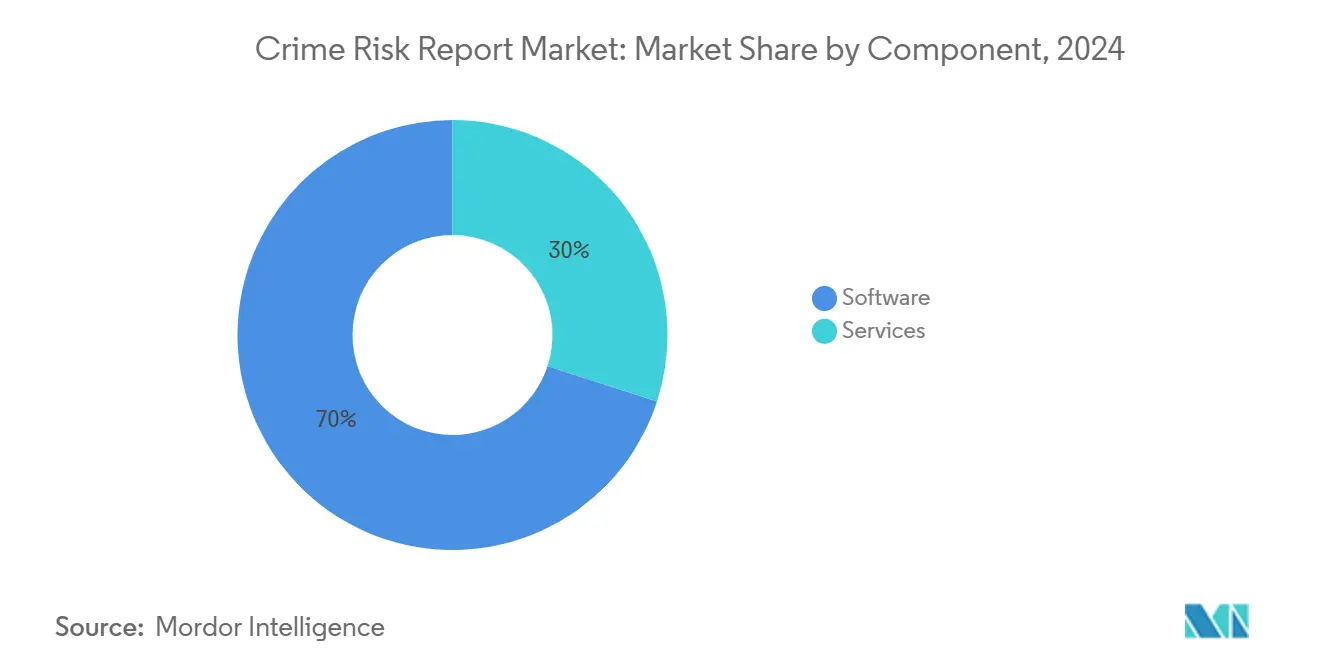
Note: Segment shares of all individual segments available upon report purchase
By Deployment: Cloud Migration Accelerates Real-Time Capabilities
Cloud delivery captured 64% of 2024 revenue, underscoring the structural swing away from on-premise mainframes toward elastic compute clusters optimized for parallel model scoring. The scale gained here translates directly into response speed: platforms like SAS’s cloud AML suite slash false positives by two-thirds while serving decisions fast enough for digital-wallet authorizations. Hybrid designs emerge when institutions wish to retain customer PII on-premise yet stream anonymized feature vectors to cloud GPUs for scoring.
Multi-cloud adoption surged following cases such as GAMA-1’s NOAA replication exercise, proving terabyte-scale mobility across providers. Spending on infrastructure-as-a-service hit USD 94 billion in Q1 2025, a 23% lift year-over-year, and much of that budget fuels crime-analytics container clusters. Conversely, institutions bound by data-sovereignty statutes still procure hardened local appliances, but their share within the Crime Risk Report market is eroding as service-level agreements and encryption frameworks mature.
By End-User Industry: Banking Leads Amid Insurance Acceleration
Banks generated 47.5% of sectoral sales in 2024, a logical outcome given their statutory obligations to file Suspicious Activity Reports within specific deadlines and their exposure to the USD 255 million enforcement action against CashApp earlier in 2025. Machine-learning engines now flag micro-anomalies across digital, branch, and ATM channels, compressing manual review queues and trimming operational expense.
Insurers, while smaller today, grow at 17.5% CAGR as usage-based policies and sensor-rich vehicles flood underwriting desks with high-frequency data that demand AI-assisted fraud scoring. Real-estate intermediaries step up adoption in preparation for FinCEN’s disclosure rule, deploying beneficial-ownership graph databases that spot nominee buyers hidden behind liability companies. Law-enforcement agencies gain traction through grants funding predictive-policing pilots, translating crime-hotspot forecasts into patrol scheduling. Collectively these verticals diversify the Crime Risk Report market, cushioning it against cyclical downturns in any single sector.
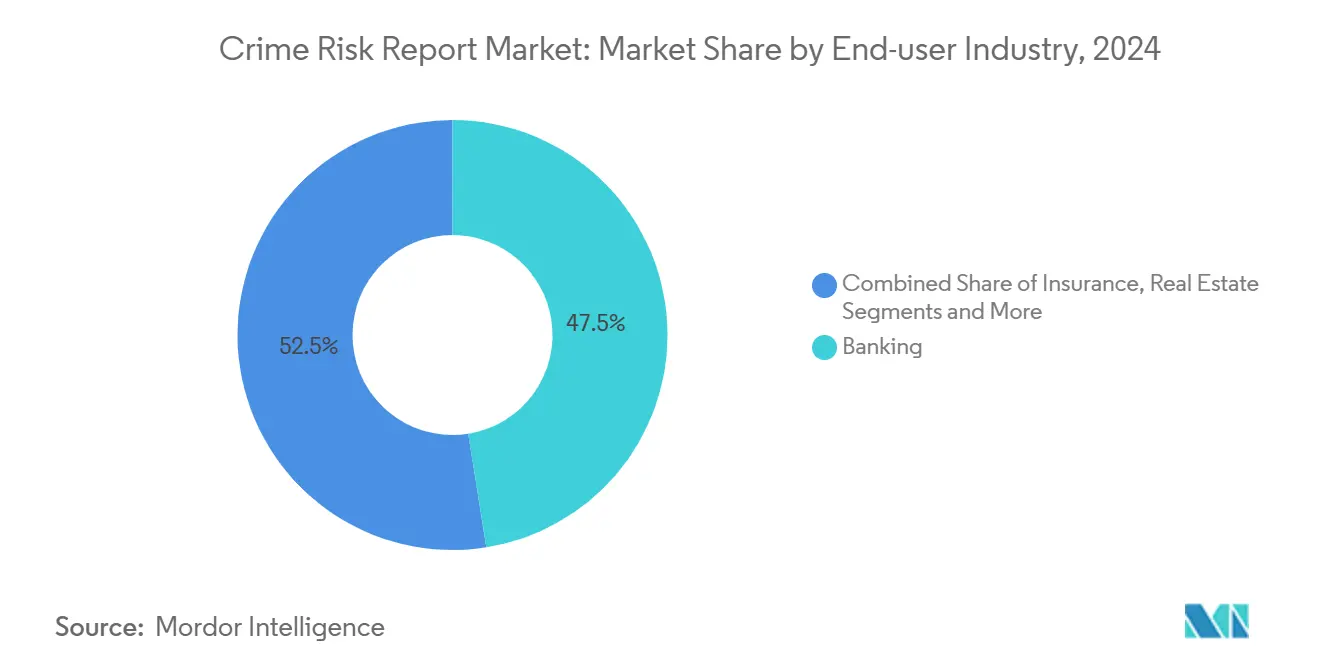
Note: Segment shares of all individual segments available upon report purchase
By Solution Type: Fraud Detection Leads While Investigation Platforms Surge
Fraud-detection and AML modules held 34.8% of 2024 turnover and remain compulsory purchases because they automate sanctions filters and transaction-monitoring rule sets. Their technical spine is shifting from heuristics to deep-learning ensembles specialized for cross-border payments, buy-now-pay-later rails, and emerging CBDC pilots. Intelligence and investigation platforms grow fastest at 20.1% CAGR because agencies want unified workspaces that stitch together alerts, case files, social-media footprints, and court-record metadata.
Crime mapping suites fuse geospatial heat maps with demographic overlays to streamline resource allocation for city police chiefs. KYC compliance engines bolster onboarding by verifying IDs against authoritative registries in real time, increasingly using cryptographic verifiable credentials. Property crime-risk scoring solutions, though nascent, appeal to mortgage lenders and insurers that need a quantifiable link between neighborhood crime and asset valuation. Vendors that interweave these modules into a coherent, low-code platform are best positioned to capture a larger slice of the Crime Risk Report market size.
Geography Analysis
North America maintained 39% revenue in 2024 on the back of robust regulatory enforcement, ample venture capital for reg-tech start-ups, and public investments such as the CHIPS Act that modernize domestic compute capacity supporting advanced analytics. FinCEN’s focus on real-estate transparency tightens reporting loops around shell-company-funded purchases, opening new workloads for AI graph-analysis engines. Canada’s money-laundering risk assessment flagged real estate as a high-risk sector, pushing lenders and brokers to integrate crime-risk scores into due-diligence checklists.
Europe’s trajectory is anchored in GDPR alignment and forthcoming AI governance rules that prioritize explainability. Germany’s AI strategy stresses human-centric risk models, stimulating demand for transparent algorithms that can withstand regulatory audits. Europol’s 2024–2026 programming document itemizes investments in data-fusion platforms to enhance cross-border intelligence, indirectly expanding the addressable Crime Risk Report market within government contracts. With stringent data-protection regimes, European institutions often adopt edge-compute or sovereign-cloud patterns, a nuance vendors must address to secure local certifications.
Asia–Pacific posted the fastest CAGR at 18%, reflecting widespread digital-payment adoption and aggressive scam activity that cost Southeast Asian economies USD 18–37 billion in 2023 alone. Australia will fold roughly 80,000 additional entities into AML oversight from July 2026, compelling an upgrade cycle for compliance software. Japan’s draft Basic Act on Responsible AI is shaping procurement criteria that favor bias-audited models. Emerging financial hubs like Singapore are also issuing granular advisories on crypto-asset tracing, further boosting regional demand.
Latin America and the Middle East and Africa remain smaller but strategically relevant. Rising real-time payment adoption in Brazil and Saudi Arabia increases exposure to authorized push-payment fraud, prompting domestic banks to pilot AI-enabled behavioral analytics. Capacity-building grants from multilateral bodies help local regulators establish beneficial-ownership registries and e-filing portals, laying the groundwork for gradual Crime Risk Report market penetration.
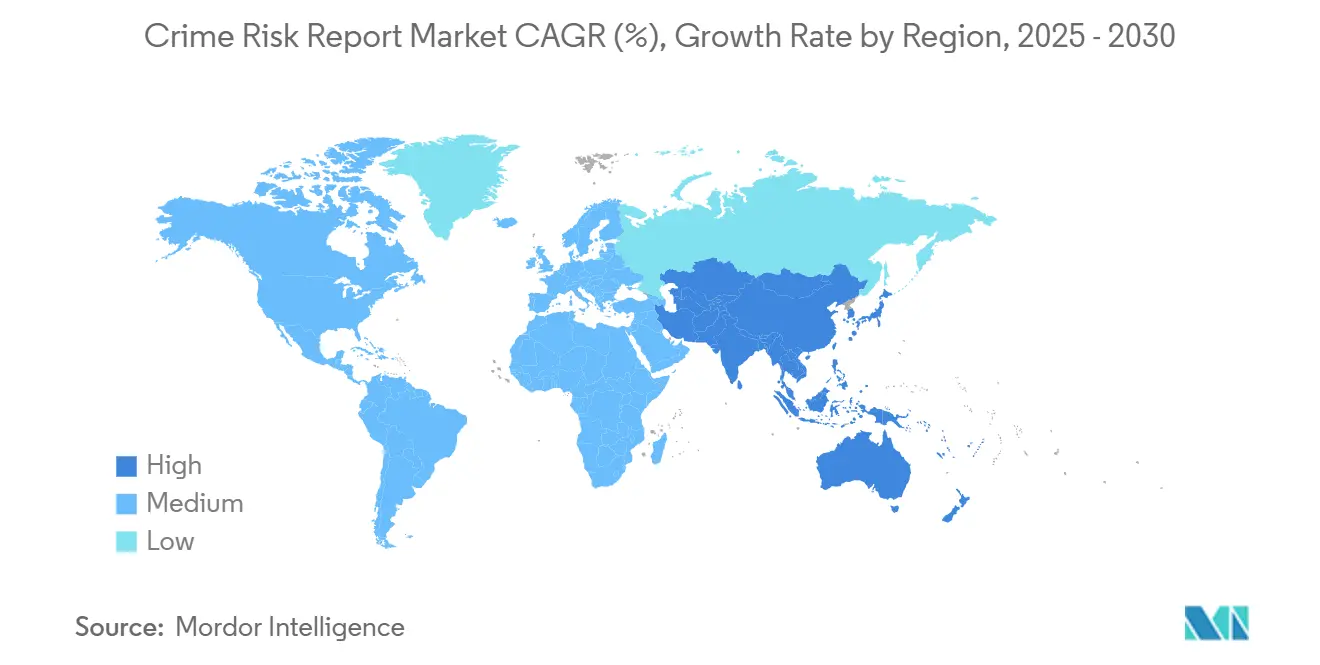
Competitive Landscape
The Crime Risk Report market is moderately fragmented yet steeply stratified by intellectual property depth. IBM holds more than 63,000 active patents, including portfolios focused on adversarial-resilient machine-learning, while FICO owns 101 fraud-specific AI patents. Microsoft continues to embed real-time graph analytics inside its Azure Data services, securing share among cloud-first banks. These incumbents cross-license technology or form co-development pacts—SAS and Neterium’s alliance is a recent example—to compress launch timelines for cloud-native modules.
Specialist disruptors such as Flagright concentrate on low-code AML orchestration, claiming to shorten investigation cycles by automating policy mapping and risk scoring. Their traction is strongest with mid-tier banks needing rapid deployment at modest budgets. Infrastructure integrators like Kyndryl wield patent estates in multi-cloud management, a capability attractive to regulated entities that must operate across sovereign clouds.
Strategic moves in 2024–2025 underscore a pivot toward open-API ecosystems. Palantir expanded its Foundry platform with AML compliance extensions aimed at commercial clients, broadening a toolkit previously reserved for government buyers. Oracle stitched financial crime services into its Autonomous Database, using machine-generated feature engineering to accelerate model updates. Competition now centers on interpretability dashboards, synthetic-data generators for privacy-preserving model training, and model governance toolkits capable of automated bias scoring.
Crime Risk Report Industry Leaders
-
ACI Worldwide, Inc.
-
Fenergo Ltd
-
Fiserv, Inc.
-
IBM Corp.
-
Oracle Corporation
- *Disclaimer: Major Players sorted in no particular order
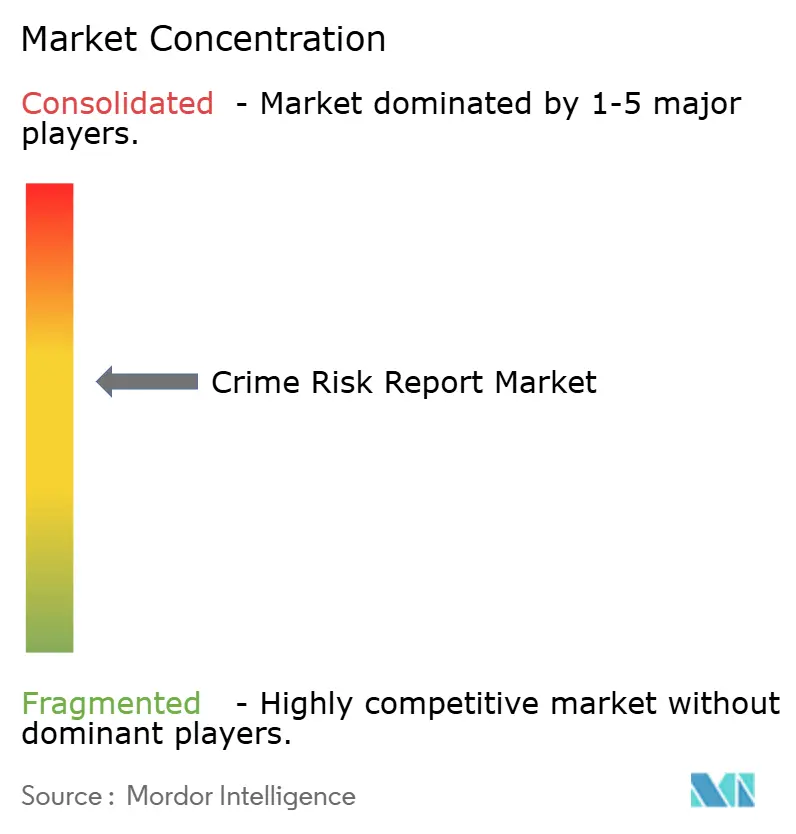


Recent Industry Developments
- June 2025: GAMA-1 Technologies replicated 97 TB of NOAA data across three hyperscale clouds, illustrating scalable transfer methods relevant for crime-analytics datasets (cbs42).
- January 2025: Flagright released a regulatory outlook detailing heightened FATF scrutiny of virtual-asset service providers (flagright).
- December 2024: SAS unveiled a real-time watch-list screening engine with Neterium, reducing false alerts by 65% and offering instant model-tuning through a cloud-native console (sas).
- November 2024: Europol’s 2024–2026 document earmarked further data-fusion platform spending to support member-state investigations (europol).
Research Methodology Framework and Report Scope
Market Definitions and Key Coverage
Our study defines the crime risk report market as subscription-based analytics platforms and on-demand location reports that convert multi-source crime, demographic, and compliance data into actionable risk scores for enterprises, insurers, lenders, public agencies, and real-estate stakeholders. According to Mordor Intelligence, this global market is valued at USD 11.5 billion in 2025.
Scope Exclusions: Physical guarding, CCTV hardware, and one-off investigative projects fall outside our remit.
Segmentation Overview
- By Component
- Software
- Services
- By Deployment
- On-Premise
- Cloud-based
- By End-user Industry
- Banking
- Insurance
- Real Estate
- Law-Enforcement and Public Safety Agencies
- Other Industries (utilities, retail, telecom)
- By Solution Type
- Fraud Detection and AML
- Crime Mapping and Predictive Analytics
- Compliance and KYC Reporting
- Property Crime-Risk Scoring
- Intelligence and Investigation Platforms
- By Geography
- North America
- United States
- Canada
- Mexico
- South America
- Brazil
- Argentina
- Rest of South America
- Europe
- Germany
- United Kingdom
- France
- Italy
- Spain
- Rest of Europe
- Asia-Pacific
- China
- Japan
- India
- South Korea
- Australia and New Zealand
- Rest of Asia-Pacific
- Middle East
- Israel
- Saudi Arabia
- United Arab Emirates
- Turkey
- Rest of Middle East
- Africa
- South Africa
- Nigeria
- Egypt
- Rest of Africa
- North America
Detailed Research Methodology and Data Validation
Primary Research
Mordor analysts interviewed compliance officers, real-estate underwriters, state data stewards, and SaaS executives across North America, Europe, and Asia-Pacific. Their insights on license pricing, cloud adoption, and emerging KYC mandates allowed us to refine assumptions before finalizing forecasts.
Desk Research
We collected baseline metrics from tier-one public sources such as the FBI Crime Data Explorer, UNODC homicide statistics, FATF typology updates, Europol cyber-crime threat reports, and HUD neighborhood crime heat-maps. Company filings, earnings calls, and investor decks clarified vendor revenue splits, while Dow Jones Factiva and D&B Hoovers helped us verify addressable players and pricing. These inputs anchored incidence rates, compliance spend, and average license fees that flow into our model. The sources named are illustrative; many additional journals, trade bodies, and open databases informed further validation.
Market-Sizing & Forecasting
We employ a top-down and bottom-up blend: national crime statistics and regulatory compliance outlays build an addressable demand pool, which is then reconciled with sampled vendor revenues and average subscription prices. Key variables include digital-payment volume growth, AML penalty totals, cloud deployment share, urban-population expansion, and enterprise security budgets. A multivariate regression linked to historical sales and exponential smoothing projects each line through 2030, with gap-filling based on regional penetration norms where raw data are scarce.
Data Validation & Update Cycle
Outputs face variance tests against independent benchmarks, a four-eye analyst review, and re-contact of respondents when anomalies surface. Reports refresh annually, with interim updates triggered by material regulatory changes or major security incidents, so clients receive the latest view.
Why Mordor's Crime Risk Report Baseline Delivers Highly Dependable Insight
Published estimates often diverge because research firms vary market scope, revenue attribution, and refresh cadence. Our baseline leans on crime-specific demand indicators and yearly primary checks, striking a balanced middle path between conservative incident-trend models and aggressive SaaS roll-ups.
Key gap drivers include whether personal-crime mapping is counted, if professional-service revenue is bundled, the currency year applied, and the treatment of cloud price erosion.
Benchmark comparison
| Market Size | Anonymized source | Primary gap driver |
|---|---|---|
| USD 11.5 Bn | Mordor Intelligence | - |
| USD 11.42 Bn | Global Consultancy A | Includes personal and property-crime dashboards excluded by Mordor |
| USD 11.34 Bn | Industry Insights B | Bundles implementation services and uses blended 2024 FX rates |
These comparisons show that by isolating core software and report revenues and validating them against fresh regulatory-spend data, Mordor Intelligence provides a transparent, repeatable baseline decision-makers can trust.


Key Questions Answered in the Report
How big is the Crime Risk Report market today?
The Crime Risk Report market size reached USD 11.09 billion in 2025 and is projected to climb to USD 22.6 billion by 2030 at a 15.4% CAGR.
Which end-user sector invests the most in crime-risk analytics?
Banking institutions lead, representing 47.5% of 2024 revenue, driven by stringent AML obligations and elevated fraud threats.
Why is cloud deployment gaining dominance?
Cloud models already hold 64% market share because they deliver elastic compute power that supports real-time watch-list screening and reduces false positives by up to 65%.
What region offers the fastest growth opportunity?
Asia–Pacific is advancing at a 18% CAGR through 2030, buoyed by regulatory expansion in countries such as Australia and escalating digital-payment fraud levels.
How are regulations shaping product demand?
New rules FinCEN’s real-estate reporting mandate and FATF’s virtual-asset guidance—require immediate, AI-enabled surveillance, prompting institutions to adopt platforms capable of millisecond-level anomaly detection.
What differentiates leading vendors in this market?
Patent depth, cloud-native architecture, and explainability toolkits set top suppliers apart, while partnerships like SAS–Neterium illustrate the trend toward joint innovation to accelerate compliance capabilities.
Page last updated on:
